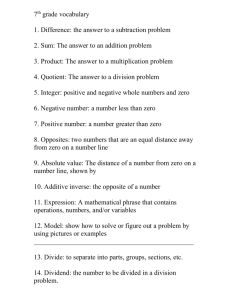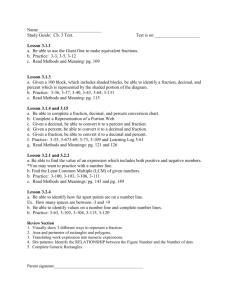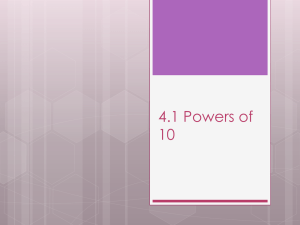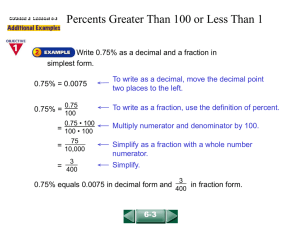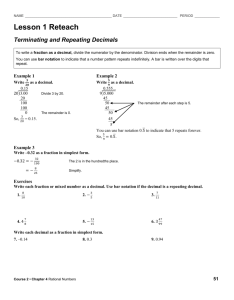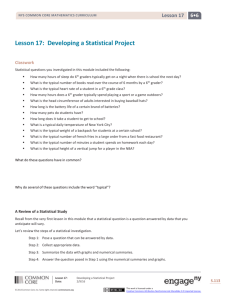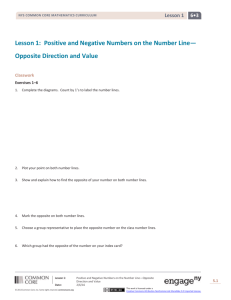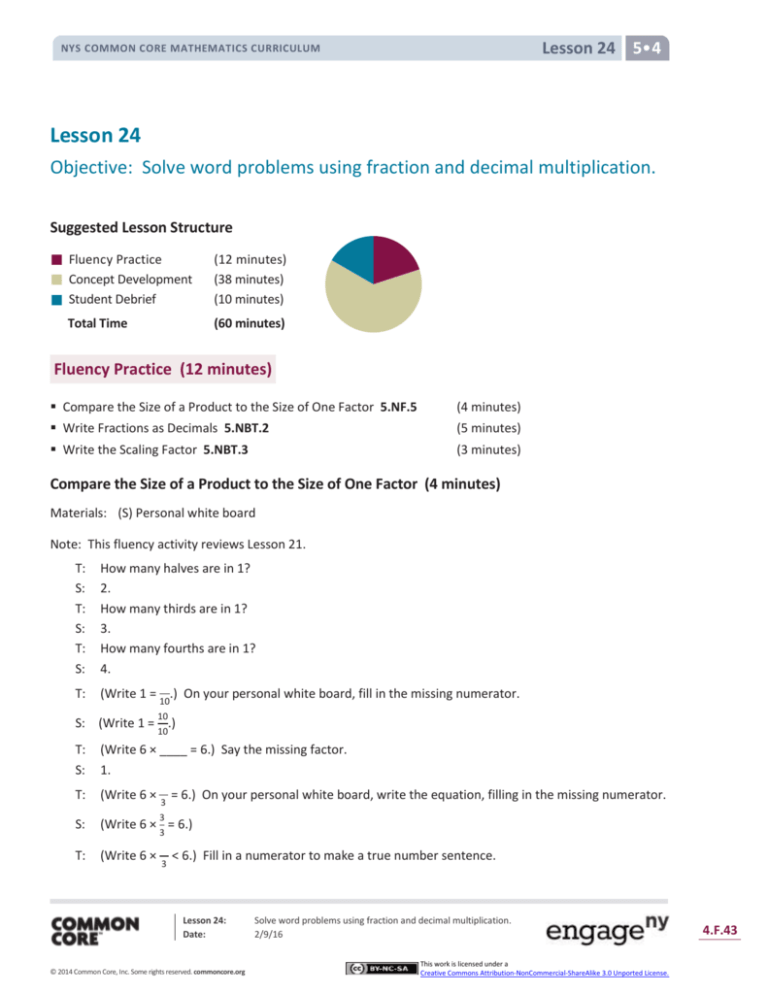
Lesson 24 5 4
NYS COMMON CORE MATHEMATICS CURRICULUM
Lesson 24
Objective: Solve word problems using fraction and decimal multiplication.
Suggested Lesson Structure
Fluency Practice
Concept Development
Student Debrief
Total Time
(12 minutes)
(38 minutes)
(10 minutes)
(60 minutes)
Fluency Practice (12 minutes)
Compare the Size of a Product to the Size of One Factor 5.NF.5
(4 minutes)
Write Fractions as Decimals 5.NBT.2
(5 minutes)
Write the Scaling Factor 5.NBT.3
(3 minutes)
Compare the Size of a Product to the Size of One Factor (4 minutes)
Materials: (S) Personal white board
Note: This fluency activity reviews Lesson 21.
T:
S:
T:
S:
T:
S:
How many halves are in 1?
2.
How many thirds are in 1?
3.
How many fourths are in 1?
4.
T:
(Write 1 = 10.) On your personal white board, fill in the missing numerator.
10
S: (Write 1 = 10.)
T:
S:
(Write 6 × ____ = 6.) Say the missing factor.
1.
T:
(Write 6 ×
S:
(Write 6 ×
T:
(Write 6 ×
= 6.) On your personal white board, write the equation, filling in the missing numerator.
3
3
=
3
3
6.)
< 6.) Fill in a numerator to make a true number sentence.
Lesson 24:
Date:
© 2014 Common Core, Inc. Some rights reserved. commoncore.org
Solve word problems using fraction and decimal multiplication.
2/9/16
This work is licensed under a
Creative Commons Attribution-NonCommercial-ShareAlike 3.0 Unported License.
4.F.43
Lesson 24 5 4
NYS COMMON CORE MATHEMATICS CURRICULUM
1
2
S:
(Write 6 × 3 < 6 or 6 × 3 < 6.)
T:
(Write 9 ×
S:
(Write a number sentence, filling in a numerator greater than 6.)
6
> 9.) Fill in a numerator to make a true number sentence.
Continue this process with the following possible sequence:
and
5
2
× 5 = 5,
2
× 5 < 5,
2
× 5 > 5,
4
× 9 < 9,
6
× 8 = 8,
× 7 < 7.
Write Fractions as Decimals (5 minutes)
Materials: (S) Personal white board
Note: This fluency activity reviews Lesson 23.
1
50
T:
(Write
S:
2.
T:
(Write 50 × 2 = 100.)
S:
2 hundredths.
T:
(Write 50 × 2 = 100. Below it, write 50 = ____.____.) On your personal white board, write 50 as a
1
1
=
.) How many fifties are in 100?
100
2
2
1
50
is the same as how many hundredths?
2
1
1
decimal.
S:
1
(Write 50 = 0.02.)
Continue this process with the following possible sequence:
1 3
,
4 4
, and
3 9
, ,
50 50
9
4 50 ,
1 3
,
20 20
3
1 3 8
1
9
9
, 4 20 , 5 , 5 , 5 , 25 , 25 , 5 25 ,
15
.
4
Write the Scaling Factor (3 minutes)
Materials: (S) Personal white board
Note: This fluency activity reviews Lesson 23.
T:
S:
T:
S:
T:
S:
T:
S:
(Write 3 × ____ = 3.) Say the unknown whole number factor.
1.
(Write 3.5 × ____ = 3.5.) Say the unknown whole number factor.
1.
(Write 4.2 × 1 = ____.) Say the product.
4.2.
(Write ____ × 0.58 > 0.58.) Is the unknown factor greater or less than 1?
Greater than 1.
Lesson 24:
Date:
© 2014 Common Core, Inc. Some rights reserved. commoncore.org
Solve word problems using fraction and decimal multiplication.
2/9/16
This work is licensed under a
Creative Commons Attribution-NonCommercial-ShareAlike 3.0 Unported License.
4.F.44
Lesson 24 5 4
NYS COMMON CORE MATHEMATICS CURRICULUM
T:
S:
T:
S:
T:
Fill in a factor to make a true number sentence.
(Write a number sentence filling in a decimal number greater than 1.)
(Write 7.03 × ____ < 7.03.) Is the unknown factor greater or less than 1?
Less than 1.
Fill in a factor to make a true number sentence.
Continue this process with the following possible sequence: 6.07 × ____ < 6.07, ____ × 6.2 = 6.2, and
0.97 × ____ > 0.97.
Concept Development (38 minutes)
Materials: (S) Problem Set
Note: The time normally allotted for the Application Problem has been included in the Concept Development
portion of today’s lesson.
Suggested Delivery of Instruction for Solving Lesson 24 Word Problems
1. Model the problem.
Have two pairs of student who can successfully model the problem work at the board while the other
students work independently or in pairs at their seats. Review the following questions before beginning the
first problem:
Can you draw something?
What can you draw?
What conclusions can you make from your drawing?
As students work, circulate. Reiterate the questions above. After two minutes, have the two pairs of students
share only their labeled diagrams. For about one minute, have the demonstrating students receive and
respond to feedback and questions from their peers.
2. Calculate to solve and write a statement.
Give students two minutes to finish work on that question, sharing their work and thinking with a peer. All
students should write their equations and statements of the answer.
3. Assess the solution for reasonableness.
Give students one to two minutes to assess and explain the reasonableness of their solution.
Lesson 24:
Date:
© 2014 Common Core, Inc. Some rights reserved. commoncore.org
Solve word problems using fraction and decimal multiplication.
2/9/16
This work is licensed under a
Creative Commons Attribution-NonCommercial-ShareAlike 3.0 Unported License.
4.F.45
Lesson 24 5 4
NYS COMMON CORE MATHEMATICS CURRICULUM
Problem 1
1
A vial contains 20 mL of medicine. If each dose is 8 of the vial, how many mL is each dose? Express your
answer as a decimal.
In this fraction of a set problem, students are asked to find one-eighth of 20 mL. Since the final answer must
be expressed as a decimal, students again have some choices in how they solve. As illustrated, some students
1
may choose to multiply 8 by 20 to find the fractional mL in each dose. This method requires students to then
1
simply express 2 2 as a decimal.
1
Other students may choose to first express 8 as a decimal (0.125), and then multiply that by 20 to find 2.5 mL
of medicine per dose. This method is perhaps more direct, but it does require that students recall that 8 is a
1
factor of 1,000 to express as a decimal.
8
Problem 2
3
A container holds 0.7 liters of oil and vinegar. 4 of the mixture is vinegar. How many liters of vinegar are in
the container? Express your answer as both a fraction and a decimal.
In this fraction of a set problem, students are asked to find three-fourths of a set that is expressed using a
decimal. Since the final answer needs to be expressed as both a fraction and decimal, students again have
choices in their approaches. As illustrated, some students may choose to express 0.7 as a fraction, and then
multiply by three-fourths to find the fractional liters of vinegar in the container. This method requires the
slightly complex step of converting a fraction with a denominator of 40 to a decimal. This process is not
extremely challenging, but perhaps unfamiliar to some students.
3
Other students may choose to first express 4 as a decimal (0.75), and then multiply it by 0.7 to find that 0.525
liters of vinegar are in the container. The decimal 0.525 is easily written as
525
as
1,000
a fraction. Students may
simplify this fraction, but it is not required.
Lesson 24:
Date:
© 2014 Common Core, Inc. Some rights reserved. commoncore.org
Solve word problems using fraction and decimal multiplication.
2/9/16
This work is licensed under a
Creative Commons Attribution-NonCommercial-ShareAlike 3.0 Unported License.
4.F.46
Lesson 24 5 4
NYS COMMON CORE MATHEMATICS CURRICULUM
Problem 3
1
Andres completed a 5-km race in 13.5 minutes. His sister’s time was 1 2 times longer than his time. How
long, in minutes, did it take his sister to run the race?
In this problem, Andres’ race time (13.5 minutes) is being
1
multiplied by a scaling factor of 1 2. Students must interpret
both a decimal and fractional factor, thus resulting in the
expression of both factors as either decimals or fractions
5
1
135
3
(13 10 × 1 2 or 10 × 2). Alternatively, students may have chosen
to draw a tape diagram showing Andres’ sister’s time as 1 and a
half times more than his. In this manner, students must
multiply to find the value of the half-unit that represents the
additional time his sister spent running, and then add that sum
to 13.5 minutes. The student’s choice of approach provides an
opportunity to discuss the efficiency of both approaches during
the Student Debrief. In any case, students should find that
1
Andres’ sister completed the race in 20.25 (or 20 4) minutes.
Lesson 24:
Date:
© 2014 Common Core, Inc. Some rights reserved. commoncore.org
NOTES ON
MULTIPLE MEANS
OF REPRESENTATION:
Problems 3, 4, and 5 require students
to compare quantities. For example, in
Problem 3, students compare Andres’
race time to his sister’s time. Typically,
when using tape diagrams to solve
comparison word problems, at least
two bars are used.
There is a strong connection between
tape diagrams used with comparison
story problems and bar graphs. The
bars in bar graphs allow readers to
compare quantities, which is similar to
the bars used in comparison word
problems. Although tape diagrams are
typically drawn horizontally, they can
be drawn vertically. Similarly, bar
graphs can (and should) be drawn
horizontally and vertically. In Problems
3, 4, and 5, it is easy to visualize
additional data that would result in
additional bars.
Solve word problems using fraction and decimal multiplication.
2/9/16
This work is licensed under a
Creative Commons Attribution-NonCommercial-ShareAlike 3.0 Unported License.
4.F.47
Lesson 24 5 4
NYS COMMON CORE MATHEMATICS CURRICULUM
Problem 4
3
A clothing factory uses 1,275.2 meters of cloth a week to make shirts. How much cloth is needed to make 3 5
times as many shirts?
3
In this scaling problem, a length of cloth (1,275.2 m) is multiplied by a scaling factor of 3 5. Before students
solve, ask them to identify the scaling factor and what comparison is being made (that of the initial amount of
fabric and resulting amount). Though students do have the option of expressing both factors as fractions, the
3
method of converting 3 to a decimal is far simpler. The efficiency of this approach can be a focus during the
5
Student Debrief. Some students may also have chosen to draw a tape diagram showing 1,275.2 meters of
3
cloth being scaled to 3 times its original length. In this manner, students could have tripled 1,275.2 first, and
5
then found three-fifths of it before combining those two totals. In either case, students should find that the
factory would need 4,590.72 meters of cloth.
Problem 5
3
There are as many boys as girls in a class of fifth-graders. If there are 35 students in the class, how many are
4
girls?
What may seem like a simple problem is actually rather challenging because students are required to work
3
backwards as they solve. The word problem states that there are 4 as many boys as girls in the class, yet the
Lesson 24:
Date:
© 2014 Common Core, Inc. Some rights reserved. commoncore.org
Solve word problems using fraction and decimal multiplication.
2/9/16
This work is licensed under a
Creative Commons Attribution-NonCommercial-ShareAlike 3.0 Unported License.
4.F.48
Lesson 24 5 4
NYS COMMON CORE MATHEMATICS CURRICULUM
number of girls is unknown. Students should first reason that, since the number of boys is a scaled multiple
of the number of girls, a tape should first be drawn to represent the girls. From that tape, students can draw
a smaller tape (one that is three-fourths the size of the tape representing the girls) to represent the boys in
the class. In this way, students can see that 3 units are boys, and 4 units are girls. Since there are 35 students
in the class and 7 total units, each unit represents 5 students. Four of those units are girls, so there are 20
girls in the class.
Problem 6
4
Ciro purchased a concert ticket for $56. The cost of the ticket was 5 the cost of his dinner. The cost of his
1
hotel was 2 2 times as much as his ticket. How much did Ciro spend altogether for the concert ticket, hotel,
and dinner?
In this problem, students must read and work carefully to
identify that the cost of the concert ticket plays two roles.
In relation to the cost of the dinner, the ticket cost can be
4
considered the scaling factor because it represents 5 the
cost of dinner. However, in relation to the cost of the
hotel, the ticket cost should be considered the factor
1
being scaled (because the hotel cost is 2 2 times greater).
This understanding is crucial for drawing an accurate
model and should be discussed thoroughly as students
draw, as well as repeated during the Student Debrief.
Once the modeling is complete, the steps toward finding a
solution are relatively simple. Since the ticket cost
4
represents 5 the cost of dinner, division shows that each
unit (or fifth) is equal to $14. Therefore, 5 units (5 fifths),
or the cost of dinner, is equal to $70. The model
representing the cost of the hotel very clearly shows 2
units of $56 and a half unit of $56, which, in total, equals
$140. Students must use addition to find the total cost of
Ciro’s spending.
Lesson 24:
Date:
© 2014 Common Core, Inc. Some rights reserved. commoncore.org
Solve word problems using fraction and decimal multiplication.
2/9/16
This work is licensed under a
Creative Commons Attribution-NonCommercial-ShareAlike 3.0 Unported License.
4.F.49
Lesson 24 5 4
NYS COMMON CORE MATHEMATICS CURRICULUM
Student Debrief (10 minutes)
Lesson Objective: Solve word problems using fraction and
decimal multiplication.
The Student Debrief is intended to invite reflection and
active processing of the total lesson experience.
Invite students to review their solutions for the Problem
Set. They should check work by comparing answers with a
partner before going over answers as a class. Look for
misconceptions or misunderstandings that can be
addressed in the Debrief. Guide students in a
conversation to debrief the Problem Set and process the
lesson.
You may choose to use any combination of the questions
below to lead the discussion.
For all the problems in this Problem Set, there are
several ways to solve for the solutions. With a
partner, compare and share your strategies for
each step in Problem 4.
How did you solve Problem 5? Explain your
strategy to a partner. Can you find how many boys
there are in the classroom? How many more girls
than boys are in the classroom?
Did you make any drawings or tape diagrams for
Problem 6? Share and compare with a partner.
Does drawing a tape diagram help you solve this
problem? Explain.
Exit Ticket (3 minutes)
After the Student Debrief, instruct students to complete the Exit
Ticket. A review of their work will help you assess the students’
understanding of the concepts that were presented in the
lesson today and plan more effectively for future lessons. You
may read the questions aloud to the students.
Lesson 24:
Date:
© 2014 Common Core, Inc. Some rights reserved. commoncore.org
NOTES ON
MULTIPLE MEANS
OF ENGAGEMENT:
A daily goal is to have students discuss
their thinking. One possible strategy to
achieve this goal is to partner each
student with a peer who has a
different perspective.
Ask students to separate themselves
into groups that solved a specific
problem in a similar way. Once these
groups are formed, ask each student to
partner with a peer in another group.
Let these partners describe and discuss
their strategies and solutions with each
other. It is more difficult for students
to explain different approaches than
similar approaches.
Solve word problems using fraction and decimal multiplication.
2/9/16
This work is licensed under a
Creative Commons Attribution-NonCommercial-ShareAlike 3.0 Unported License.
4.F.50
Lesson 24 Problem Set 5•4
NYS COMMON CORE MATHEMATICS CURRICULUM
Name
Date
1
8
1. A vial contains 20 mL of medicine. If each dose is of the vial, how many mL is each dose? Express your
answer as a decimal.
2. A container holds 0.7 liters of oil and vinegar.
3
4
of the mixture is vinegar. How many liters of vinegar are
in the container? Express your answer as both a fraction and a decimal.
1
3. Andres completed a 5-km race in 13.5 minutes. His sister’s time was 1 2 times longer than his time. How
long, in minutes, did it take his sister to run the race?
Lesson 24:
Date:
© 2014 Common Core, Inc. Some rights reserved. commoncore.org
Solve word problems using fraction and decimal multiplication.
2/9/16
This work is licensed under a
Creative Commons Attribution-NonCommercial-ShareAlike 3.0 Unported License.
4.F.51
NYS COMMON CORE MATHEMATICS CURRICULUM
Lesson 24 Problem Set 5•4
4. A clothing factory uses 1,275.2 meters of cloth a week to make shirts. How much cloth is needed to make
3
3 5 times as many shirts?
3
5. There are 4 as many boys as girls in a class of fifth-graders. If there are 35 students in the class, how many
are girls?
4
6. Ciro purchased a concert ticket for $56. The cost of the ticket was 5 the cost of his dinner. The cost of his
1
hotel was 2 2 times as much as his ticket. How much did Ciro spend altogether for the concert ticket,
hotel, and dinner?
Lesson 24:
Date:
© 2014 Common Core, Inc. Some rights reserved. commoncore.org
Solve word problems using fraction and decimal multiplication.
2/9/16
This work is licensed under a
Creative Commons Attribution-NonCommercial-ShareAlike 3.0 Unported License.
4.F.52
NYS COMMON CORE MATHEMATICS CURRICULUM
Name
Lesson 24 Exit Ticket 5•4
Date
1. An artist builds a sculpture out of metal and wood that weighs 14.9 kilograms.
3
4
of this weight is metal,
and the rest is wood. How much does the wood part of the sculpture weigh?
2. On a boat tour, there are half as many children as there are adults. There are 30 people on the tour.
How many children are there?
Lesson 24:
Date:
© 2014 Common Core, Inc. Some rights reserved. commoncore.org
Solve word problems using fraction and decimal multiplication.
2/9/16
This work is licensed under a
Creative Commons Attribution-NonCommercial-ShareAlike 3.0 Unported License.
4.F.53
NYS COMMON CORE MATHEMATICS CURRICULUM
Name
Lesson 24 Homework 5•4
Date
1. Jesse takes his dog and cat for their annual vet visit. Jesse’s dog weighs 23 pounds. The vet tells him his
5
cat’s weight is 8 as much as his dog’s weight. How much does his cat weigh?
1
8
2. An image of a snowflake is 1.8 centimeters wide. If the actual snowflake is the size of the image, what is
the width of the actual snowflake? Express your answer as a decimal.
3. A community bike ride offers a short 5.7-mile ride for children and families. The short ride is followed by
2
3
a long ride, 5 times as long as the short ride, for adults. If a woman bikes the short ride with her
children, and then the long ride with her friends, how many miles does she ride altogether?
Lesson 24:
Date:
© 2014 Common Core, Inc. Some rights reserved. commoncore.org
Solve word problems using fraction and decimal multiplication.
2/9/16
This work is licensed under a
Creative Commons Attribution-NonCommercial-ShareAlike 3.0 Unported License.
4.F.54
Lesson 24 Homework 5•4
NYS COMMON CORE MATHEMATICS CURRICULUM
3
4. Sal bought a house for $78,524.60. Twelve years later he sold the house for 2 4 times as much. What was
the sale price of the house?
4
5
5. In the fifth grade at Lenape Elementary School, there are as many students who do not wear glasses as
those who do wear glasses. If there are 60 students who wear glasses, how many students are in the fifth
grade?
2
6. At a factory, a mechanic earns $17.25 an hour. The president of the company earns 6 3 times as much for
3
each hour he works. The janitor at the same company earns 5 as much as the mechanic. How much does
the company pay for all three people employees’ wages for one hour of work?
Lesson 24:
Date:
© 2014 Common Core, Inc. Some rights reserved. commoncore.org
Solve word problems using fraction and decimal multiplication.
2/9/16
This work is licensed under a
Creative Commons Attribution-NonCommercial-ShareAlike 3.0 Unported License.
4.F.55

